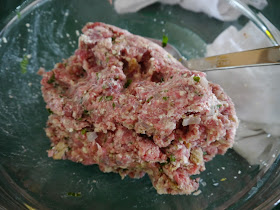If you are old enough to remember this commercial, you are probably still suffering from indigestion when you eat overly spiced foods. Today I thought I'd share a great recipe for my Nona's meatballs, which are simple, and delicious and can be made in your slow cooker. So, let's start with the sauce which you want to get into the slow cooker before you make the meatballs.
Basic Marinara in the Slow Cooker
Makes about 8 cups
2 tablespoons extra virgin olive oil
2 medium or one large sweet yellow onion, like Vidalia, of Maui sweets
2 teaspoons dried basil
Two 28 to 32-ounce cans crushed San Marzano tomatoes
One 28 to 32-ounce can San Marzano tomato puree
2 tablespoons sugar
1 teaspoon salt
1 teaspoon freshly ground black pepper
1/2 cup finely chopped Italian parsley
1/4 packed basil, finely chopped
salt and pepper to finish
In a large skillet, heat the oil, and saute the onion and basil for 3 minutes, until the onion is softened, about 3 minutes.
See that tiny meatball in there? I was testing the flavor by sauteing it in the onions for the sauce; you can also microwave for 60 seconds to cook the meatball through to see if it needs more salt/pepper/seasoning.
Transfer the mixture to the insert of a 4 to 6-quart slow cooker, and stir in the tomatoes, sugar, salt and pepper.
Cover and cook on high while making the meat balls. At the end of the cooking time, you will add the parsley and basil, and season with salt and pepper. (Marinara without meatballs can cook on high for 2 hours, low for 4)
Nona Aleandra's Meatballs
Makes about 16 2-inch meatballs, or 2 Polpetoni (grande meatballs)
3 slices Italian or French bread with soft crust torn into pieces
1/4 cup milk
2 tablespoons olive oil
1/4 cup finely chopped shallot
grated zest of one lemon
1/2 cup finely chopped Italian parsley
1 pound sweet Italian Sausage
1 pound 85% lean ground beef
1/2 cup finely grated Pecorino Romano cheese
Place the bread in a large mixing bowl, and pour the milk over the bread and allow it to be absorbed. (Cook's Note: don't squeeze out the bread, the milk helps to make the meatballs tender)
In a small skillet, heat the oil, and saute the shallot for about 3 minutes, until translucent. (Cook's Note: if you just added raw onion/shallot to this it would only taste like raw onion or shallot, make sure to cook the onion or shallot before adding it --- you could even take a few from the marinara and add them into the meatball mixture after they are sauteed---that will work)
When the shallot has cooled slightly add it to the bowl with the lemon zest parsley, sausage, beef and cheese, and mix with your hands until well combined.
Shape the meat mixture into balls, I use a portion scoop to do this, and you can make these as small or large as you like. If you would like, you can actually shape this into two 6-inch meatloaves. Using a portion scoop ensures that they all cook at the same rate; invest in a few sizes, they are great for cookies, muffins, cupcakes, and other batter.
Using a slotted spoon remove the meatballs from the sauce, skim off any fat from the top of the sauce, add fresh parsley and basil to the sauce and taste for seasoning, adding salt or pepper if needed. Serve the meatballs with pasta, or sauteed vegetables, or over mashed potatoes, or Parmesan polenta.
A Few Cook's Notes:
Lots of variations can be made the the sauce or the meatballs--you can use your favorite meat mixture (veal, pork, beef) instead of the sausage and beef---I like the flavor that the sausage gives to the meatballs. If you omit the sausage and use your favorite meat mixture, remember to use extra seasoning with the mixture.
If you would like to add wine to the sauce, 1/2 to 1 cup of a full bodied red like Chianti or Zinfandel will work. Adding the rinds from your Parmigiano Reggiano will also flavor the sauce.
We use Pecorino in this recipe because Nona was from Gubbio, in Umbria, and the regional cheese is Pecorino Romano, a sheeps' milk cheese with a sharp taste. If you would like to substitute Parmigiano, the flavor will be a little less intense. ALWAYS buy an imported Italian cheese; the difference in the dish is significant.
I hope your have a wonderful weekend; Dr. C. and I are headed to Palm Springs tomorrow to see old friends that we haven't seen in over 20 years---the weather is supposed to be in the 80's--I'll try and post some photos from the drive.










No comments:
Post a Comment